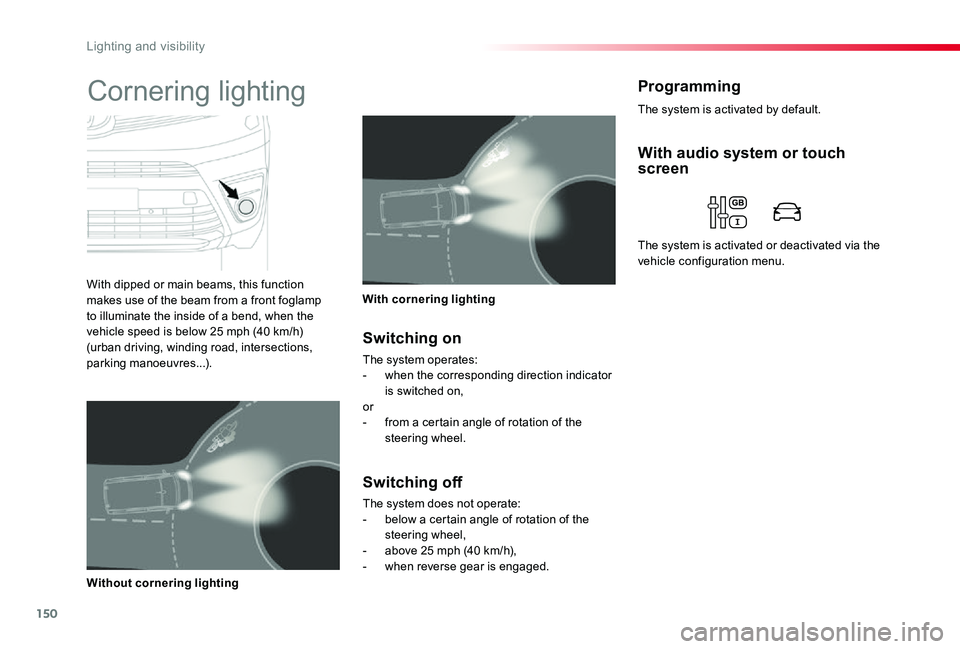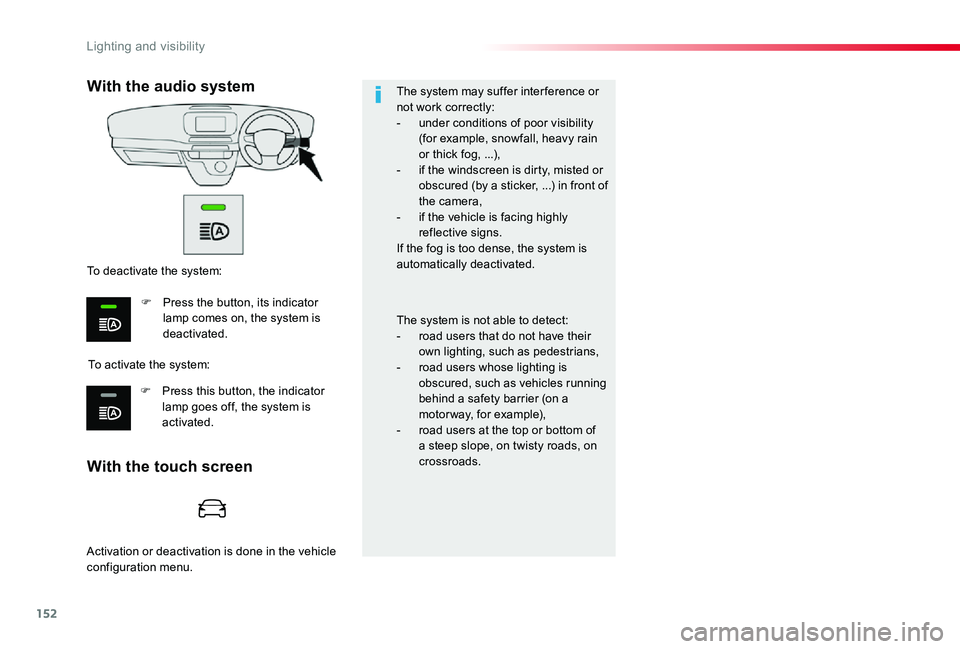2020 TOYOTA PROACE VERSO fog light
[x] Cancel search: fog lightPage 4 of 418

4
Exterior
Filler cap, fuel tank 261-262Misfuel prevention 262-263Running out of Diesel fuel, priming 322
Tyre Pressure Warning System(TPWS) 258-260Tyres, pressures 259 -260, 327ESC system 159 -161ABS, EBFD 159 -160DSC, ASR 161Toyota Traction Select 161, 162-163Snow chains 264
Front doors 65AdBlue® tank 278 -281Tool box 282-284
Automatic illumination of headlamps 147Automatic headlamp dipping 151-152Direction indicators 146Adjusting the headlamp beam height 153Changing front bulbs 298 -304Headlamp wash 156
Skyview® 120Accessories 267-268
Opening the bonnet 271
Key 45Key, remote control 45 -50Changing the battery, reinitialisation 51Smart Entry & Start System 52- 62Changing the battery, reinitialisation 62Starting - switching off the engine 198-200- key, remote control
- Smart Entry & Start System remote control
Locking - unlocking from inside 64Alarm 83-85
Road Sign Assist 221-224For ward collision warning 239 -242Autonomous emergency braking 242-244
Changing a wiper blade 269Automatic wiping 155 -156Front demisting, defrosting 131
Front foglamps 145, 299, 304Daytime running lamps 147, 300Cornering lighting 150
Parking sensors 252-253Towing 320-321
Over view
Page 11 of 418

11
Eco-driving is a range of everyday practices that allow the motorist to optimise their fuel consumption and CO2 emissions.
Eco- driving
Optimise the use of your
gearboxWith a manual gearbox, move off gently and change up without waiting. During acceleration change up early.
With an automatic or electronic gearbox, give preference to automatic mode and avoid pressing the accelerator pedal heavily or suddenly.
The gear shift indicator invites you to engage
the most suitable gear: as soon as the indication is displayed in the instrument panel, follow it straight away.For vehicles fitted with an electronic or automatic gearbox, this indicator appears only in manual mode.
Drive smoothly
Maintain a safe distance between vehicles, use engine braking rather than the brake pedal, and press the accelerator progressively. These practices contribute towards a reduction in fuel consumption and CO2 emissions and also help to reduce the background traffic noise.
If your vehicle has cruise control, make use of the system at speeds above 25 mph (40 km/h) when the traffic is flowing well.
Control the use of your
electrical equipment
Switch off the demisting and defrosting controls, if not automatic.Switch off the heated seat as soon as possible.
Switch off the headlamps and front foglamps when the level of light does not require their use.
Avoid running the engine before moving off, particularly in winter; your vehicle will warm up much faster while driving.
As a passenger, if you avoid connecting your multimedia devices (film, music, video game...), you will contribute towards limiting the consumption of electrical energy, and so of fuel.Disconnect your portable devices before leaving the vehicle.
Before moving off, if the passenger compartment is too warm, ventilate it by opening the windows and air vents before using the air conditioning.Above 30 mph (50 km/h), close the windows and leave the air vents open.Remember to make use of equipment that can help keep the temperature in the passenger compartment down (sunroof and window blinds...).Switch off the air conditioning, unless it has automatic regulation, as soon as the desired temperature is attained.
.
Eco-driving
Page 28 of 418

28
For more information on the Lighting control stalk, refer to the corresponding section.
Warning / indicator lampStateCauseAction / Observations
Front foglampsfixed.The front foglamps are switched on using the ring on the lighting control stalk.
Turn the ring on the lighting control stalk rear ward once to switch off the front foglamps.
Sidelampsfixed.The lighting stalk is in the "Sidelamps" position.
Left-hand direction indicator
flashing with buzzer.The lighting stalk has been pushed down.
Right-hand direction indicator
flashing with buzzer.The lighting stalk has been pushed up.
Dipped beam headlampsfixed.The lighting stalk is in the "Dipped beam headlamps" position.
Main beam headlampsfixed.The lighting stalk has been pulled towards you.Pull the stalk to return to dipped beam headlamps.
Lane Depar ture Alertfixed.The Lane Departure Alert has been activated.The Lane Departure Alert is on.For more information on the Lane Departure Alert, refer to the corresponding section.
Instruments
Page 145 of 418

145
Foglamp ring
Front and rear foglampsRear foglamp only
F To switch it on, turn the ring for wards.When the lighting is switched off automatically (with AUTO model), the foglamp and the dipped beam headlamps will remain on.F To switch it off, turn the ring rear wards.
Rotate and release the ring:F for wards once to switch on the front foglamps,F for wards again to switch on the rear foglamps,F rear wards once to switch off the rear foglamps,F rear wards again to switch off the front fog lamps.
When the headlamps switch off with automatic illumination of headlamps (AUTO model) or when the dipped beam headlamps are switched off manually, the foglamps and sidelamps remain on.F Turn the ring rear wards to switch off
the foglamps, the sidelamps will then switch off.
They operate with dipped beam headlamps on, in manual or auto mode.It operates with the sidelamps on.
4
Lighting and visibility
Page 146 of 418

146
Direction indicators
F Left: lower the lighting stalk, passing the point of resistance.F Right: raise the lighting stalk, passing the point of resistance.
Three flashes of the direction indicators
F Press briefly upwards or downwards,
without going beyond the point of resistance; the direction indicators will flash 3 times.
In good or rainy weather, both day and night, the front foglamps and the rear foglamps are prohibited. In these situations, the power of their beams may dazzle other drivers. They should only be used in fog or snow.In these weather conditions, it is your responsibility to switch on the foglamps and dipped headlamps manually as the sunshine sensor may detect sufficient light.Do not forget to switch off the front foglamps and the rear foglamps when they are no longer needed.
Lighting left on audible signal
An audible signal when a front door is opened warns the driver that the vehicle's exterior lighting is on, with the ignition off and in manual lighting mode.In this case, switching off the lighting stops the audible signal.
Travelling abroad
If using your vehicle in a country that drives on the other side of the road, the headlamps must be adjusted to avoid dazzling on-coming drivers.
Contact an authorized Toyota dealer or repairer, or another duly qualified and equipped professional.
The lighting goes off when you switch off the ignition, but you can always switch it on again using the lighting control stalk.
Lighting and visibility
Page 147 of 418

147
Front daytime running
lamps
(light-emitting diodes)
If fitted to your vehicle, they come on automatically when the engine is started, when the lighting control stalk is in position "0" or "AUTO".
Automatic illumination of
headlamps
Activation
When a low level of ambient light is detected by a sunshine sensor, the number plate lamps, sidelamps and dipped beam headlamps are switched on automatically, without any action on the part of the driver. They can also come on if rain is detected, at the same time as automatic operation of the windscreen wipers.As soon as the brightness returns to a
sufficient level or after the windscreen wipers are switched off, the lamps are switched off automatically.
Deactivation
F Turn the ring to another position. Deactivation of the function is accompanied by the display of a message.
Operating fault
In the event of a malfunction of the sunshine sensor, the lighting comes on; this warning lamp is displayed
Contact an authorized Toyota dealer or repairer, or another duly qualified and equipped professional.
in the instrument panel accompanied by an
audible signal and/or a message.
In fog or snow, the sunshine sensor may detect sufficient light. In this case, the lighting will not come on automatically.Do not cover the sunshine sensor, coupled with the rain sensor and located in the top of the windscreen behind the rear view mirror; the
associated functions would no longer be controlled.
F Turn the ring to the "AUTO" position. The
activation of the function is accompanied by the display of a message.
4
Lighting and visibility
Page 150 of 418

150
ProgrammingCornering lighting
With dipped or main beams, this function makes use of the beam from a front foglamp to illuminate the inside of a bend, when the vehicle speed is below 25 mph (40 km/h) (urban driving, winding road, intersections, parking manoeuvres...).
With cornering lighting
Without cornering lighting
Switching on
The system operates:- when the corresponding direction indicator is switched on,or- from a certain angle of rotation of the steering wheel.
Switching off
The system does not operate:- below a certain angle of rotation of the steering wheel,- above 25 mph (40 km/h),- when reverse gear is engaged.
With audio system or touch screen
The system is activated or deactivated via the vehicle configuration menu.
The system is activated by default.
Lighting and visibility
Page 152 of 418

152
The system may suffer interference or not work correctly:- under conditions of poor visibility (for example, snowfall, heavy rain or thick fog, ...),- if the windscreen is dirty, misted or obscured (by a sticker, ...) in front of the camera,- if the vehicle is facing highly reflective signs.If the fog is too dense, the system is automatically deactivated.
The system is not able to detect:- road users that do not have their own lighting, such as pedestrians,- road users whose lighting is obscured, such as vehicles running behind a safety barrier (on a motor way, for example),- road users at the top or bottom of
a steep slope, on twisty roads, on crossroads.With the touch screen
With the audio system
To activate the system:
To deactivate the system:
F Press the button, its indicator lamp comes on, the system is deactivated.
F Press this button, the indicator lamp goes off, the system is activated.
Activation or deactivation is done in the vehicle configuration menu.
Lighting and visibility